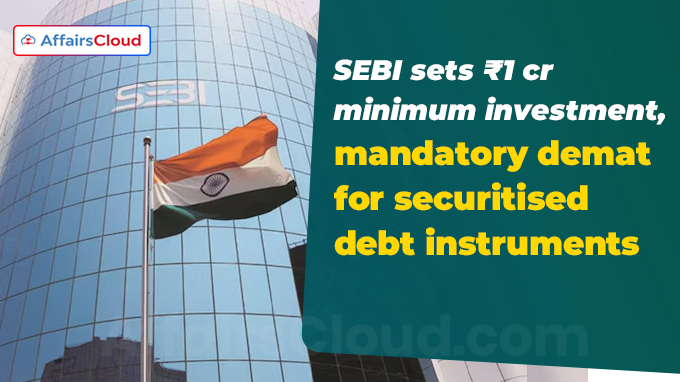 In May 2025, Mumbai (Maharashtra)-based Securities and Exchange Board of India (SEBI) has mandated minimum investment threshold or ticket size of Rs 1 crore for the issuance of Securitised Debt Instruments (SDIs) for the Reserve Bank of India (RBI)-regulated originators and unregulated entities engaged in securitization activities.
In May 2025, Mumbai (Maharashtra)-based Securities and Exchange Board of India (SEBI) has mandated minimum investment threshold or ticket size of Rs 1 crore for the issuance of Securitised Debt Instruments (SDIs) for the Reserve Bank of India (RBI)-regulated originators and unregulated entities engaged in securitization activities.
- It is now mandatory to have at least 3-year operating experience for originators. .
- SEBI issued these new rules for SDIs by amending the ‘issue and listing of securities debt instruments and security receipts’ rules.
- These new norms aim at ensuring originators maintain interest in underlying assets, promoting market stability and investor confidence.
Key Changes:
i.SEBI has clarified that for originators which are not regulated by RBI, the minimum investment threshold for subsequent transfers will be Rs 1 crore.
ii.As per SEBI’s rules, public offers for SDIs will remain open for at least 3 days and maximum 10 days, subject to the condition that advertisement requirements aligned with SEBI’s regulations for non-convertible securities.
iii.All SDIs are now required to be issued and transferred only in demat form. This rule is applicable across the board, irrespective of the nature of the originator.
iv.As per the new rules, originators are now required to hold minimum 10% of the securitized pool, or 5% in the case of receivables with a maturity period of up to 24 months (2 years).
- SEBI has further clarified that loans with maximum tenor of 2 years must be held for at least 3 months before secutritisation.
- While, for loans with tenor of more than 2 years must be held for minimum 6 months before secutritisation.
v.SEBI has also introduced an optional clean-up call for originators, which will allow them to repurchase maximum 10% of the original value of the assets.
About Securitised Debt Instruments (SDIs):
i.These are financial products developed by pooling together different types of debt like: loans, mortgages, or receivables and then selling them as securities to investors.
ii.This whole process of selling debt to investors is known as ‘securitisation’ which enables the originator i.e. bank to convert liquid assets into liquid ones, offering another source of funding.
iii.Investors who invest in these SDIs receive returns based on the performance of the underlying debt pool.
SEBI Introduced Investor Charter for KRAs to Enhance KYC Transparency, Grievance Redressal
In May 2025, SEBI introduced ‘Investor Charter’ for Know Your Customer (KYC) Registration Agencies (KRAs) providing the comprehensive details of the services offered to investors along with their rights and grievance redressal mechanism.
- This charter was introduced by SEBI through a circular issued in exercise of powers conferred under Section 11(1) of Chapter IV of the SEBI Act, 1992 to protect the interests in securities and to promote the development of, and to regulate the securities markets.
- All the directions issued in the circular will come into effect from the date of this circular.
Key Points:
i.The primary objective of developing this new charter is to facilitate investor awareness about various activities where an investor/client has to deal with KRAs for availing service requests.
Recent Related News:
In April 2025, SEBI has decided to extend its automated trading window closure mechanism to include immediate relatives of designated persons (DPs) in listed companies, ahead of the declaration of financial results.
ii.The implementation of Permanent Account Number (PAN)-based trading freeze mechanism will be carried out in two phases. Phase-I will commence on July 01, 2025, and will be applicable to the top 500 listed companies based on market capitalization.
- While remaining listed companies will be covered in phase-II, starting from October 01, 2025.



